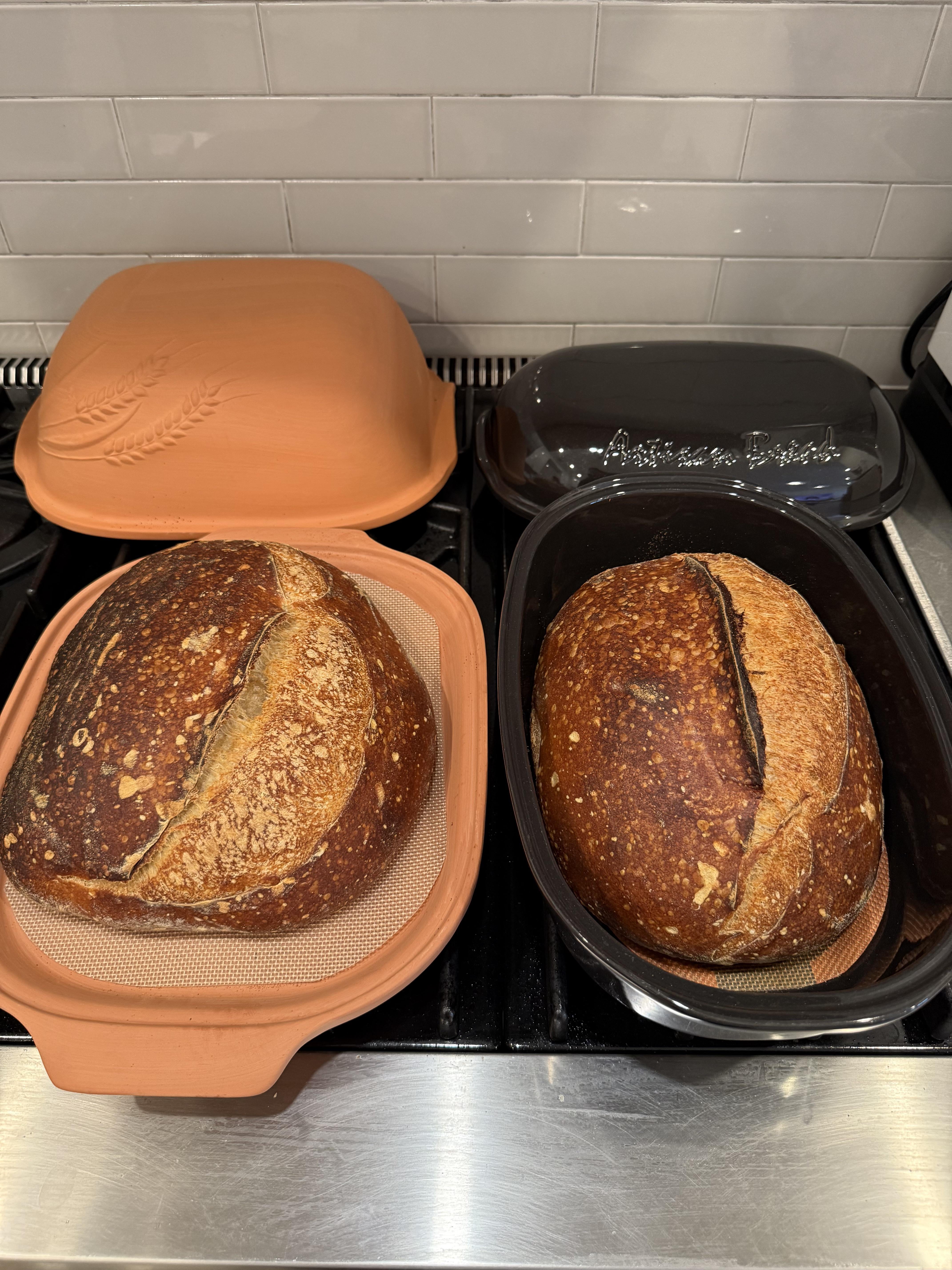
Think I over-hydrated. But it was interesting to note the different rises coming from the same batch.
Ingredients:
200g 100% levain (50/50 AP and rye)
800g water
900g KA bread flour
100g KA whole wheat flour
20g salt
Recipe:
Mix peak levain into 750g warm water and flour. Wait 15 mins.
Mix in 50g water and 20g salt. Wait 15 mins.
Rubaud kneading method on and off for next 30 mins. Wait 15 mins.
Stretch and fold. Wait 15 mins.
Stretch and fold. Wait 40 mins.
Dough has risen 20-30% (2 hr 10 mins) at 79 degrees dough temperature. Surprised it went this quick.
Preshape into two taught balls. Wait 30mins.
Shape in ovals for banneton. Cold proof in fridge at 37 degrees for 36 hours.
Spray, slash and bake with lids on for 35 mins. Lids off for 30 mins
by Wascally314


15 Comments
Additional view
https://preview.redd.it/w4x0a7qf2ece1.jpeg?width=5712&format=pjpg&auto=webp&s=d05f4239e806485b9403baebf3bf78a37bc64ca3
Did you proof these on two different shelves in your fridge?
My fridge is coldest on top. When I didn’t know that, I was proofing on any shelf that was empty, and my bottom shelf will overproof a loaf quite quickly. Perhaps the left loaf was on a warmer shelf in your fridge?
If they truly were treated the same from start to finish, then damn, this is interesting
I feel like we need a crumb shot here!
Could it be due to the color and type of material of the baking pans?
The left appears to be unglazed, and the right glazed. The left is tan and the right black.
America’s Test Kitchen tested different types of pie pans, and the color and type made a difference.
I like the taste and moistness of my 65% hydration bread but it does spread a lot in my large Dutch oven. This shot makes me think I should just get a smaller Dutch oven… thank you for sharing!!!
Curious what size Dutch ovens people typically have for round loaves?
Were the vessels preheated?
Interesting could you recreate this 🤭 could it be due to shaping differences
Variations like this can happen in the same baking vessel, caused by variations in shaping.
Any theories on why???
An hour and 10 minutes total bake time is that right?
I think this may possibly be due to different surface tensions achieved when shaping the loaves instead of the vessel. I’ve made loaves that look similar to either one in the same vessel.
Seems like a long and cool bake for that clay vessel, maybe try (I’ve just recently started doing this) 500° with the lid on for 40 min, I’ve been having huge success with that in my clay roaster.
https://preview.redd.it/nciq72byeece1.jpeg?width=3072&format=pjpg&auto=webp&s=193b79af66b3dabfa5ae72943b62bc13de8419cc
Hi. And two different loaves. They both look delicious. Interesting trial.
You don’t say if they were baked at the same time.
This is my guess at what is going on. The terracotta brick is absorbant. It will wick off steam and then release it through the wall, but the glazed pot will not, so it has a greater steam potential while the terracotta will be cooler creating more slower internal heat and greater expansion while the other tends to hotter with rapid development of skind restricting rise. When the lids came off, the more advanced glazed bake coloured more rapidly.
Hope this makes sense
Happy baking
This is 100% more due to shaping than the vessel
This looks to me like the containers just helped to hold the shape better…. The one on the left is wider and allowed the loaf to lose its shape more, while the smaller vessel helped to hold its shape.